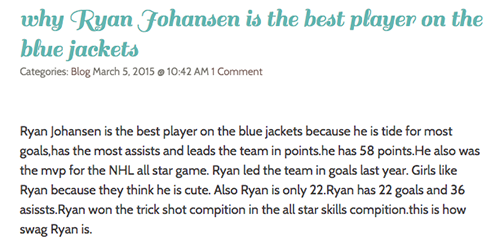Chapter 4: Responsibilities to Consider as Digital Citizens
4.2 Writing for an Audience in the Digital World

The first thing that “came up” was that our writing would be read by people who are not in the same room and who do not share our students’ experiences. We needed to make sure that our students understood they were writing for an audience that might not know them. Megan and I noticed that their posts left out information that was essential for understanding. They needed to say more so that their readers would understand and enjoy their writing as much as possible. One of Megan’s writers blogged the following post:

As Megan and I read his writing, we noticed that he lacked a sense of story, and yet we read more of his voice in this post than in his other writing. There were possibilities here that were exciting to us along with the realization that we had a lot of work to do. We needed to help our swag blogger make the connection between blogging and his other writing, and we needed to help him to see the difference as he was no longer writing only for the children in his classroom. His audience just got a lot bigger. Because of this, he really needed to think about building prior knowledge for his readers and had to work harder to make his writing meaningful to the larger audience.

My mini-lessons were very to the point. I didn’t want to spend too much time talking instead of allowing the children to work and I didn’t want to teach too much all at once. I told the children what I noticed and then I taught them what they needed to know next based on what I was seeing in their writing. For example, as Megan and I looked at the writing of our swag blogger from the example earlier, we noticed that he was writing for the children in the room, knowing that they were having a similar experience. We knew that he needed to build upon his story about learning how to blog so that his readers would know what it was like and how he felt. We noticed these same things in a lot of the writing we were looking at, so we decided that this was a priority for her class. We pulled the children together as a large group and told them we had noticed that many of them had published one or two pieces on their blogs the day before. We looked at several of the posts and talked about whether or not they had enough information in their posts for every reader to understand. The children were quick to realize that they didn’t. We took the children back to the swag blog post and worked through what that could look like for a larger audience and we revised his writing orally, allowing him to go back into the writing later. He ended up choosing not to go back into this piece, but worked harder for his audience